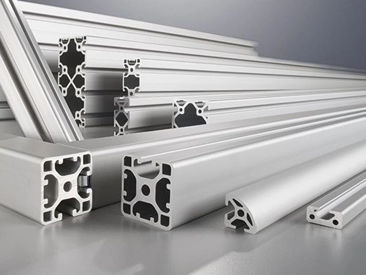
Introduction
The comparison between extruded aluminum and steel has long been a topic of interest among engineers and material scientists. The question, \"Is extruded aluminum stronger than steel?\" is not merely academic but has practical implications in industries ranging from aerospace to construction. This article delves into the mechanical properties, manufacturing processes, and applications of both materials to provide a comprehensive answer. By exploring the intricacies of Aluminum Extrusion, we aim to understand its strengths and limitations compared to steel.
Mechanical Properties of Extruded Aluminum and Steel
Extruded aluminum and steel are fundamentally different in their atomic structures, leading to variations in mechanical properties. Aluminum alloys, particularly those used in extrusion like the 6000 series, exhibit a tensile strength ranging from 150 to 350 MPa. In contrast, typical structural steels have tensile strengths between 250 and 550 MPa. While steel generally exhibits higher tensile strength, aluminum's strength-to-weight ratio often surpasses that of steel due to its lower density (approximately 2.70 g/cm³ for aluminum versus 7.85 g/cm³ for steel).
The yield strength, which indicates the stress at which a material begins to deform plastically, is also a critical factor. Extruded aluminum alloys can have yield strengths up to 310 MPa, whereas steel can reach up to 520 MPa. However, when considering specific applications where weight is a constraint, aluminum's lower density provides a higher yield strength per unit weight, making it a strong contender in lightweight design.
Impact of Alloying and Heat Treatment
Alloying elements and heat treatment processes significantly influence the mechanical properties of both materials. Aluminum alloys can be strengthened through processes like solution heat treating and aging, leading to precipitation hardening. For example, the 6061-T6 aluminum alloy undergoes such treatments to enhance its strength. Steel, on the other hand, can be strengthened through quenching and tempering, which adjust the microstructure to increase toughness and reduce brittleness.
Advanced materials like Austempered Ductile Iron (ADI) have emerged as alternatives, offering a combination of strength, ductility, and toughness. However, aluminum extrusion remains advantageous in applications requiring complex cross-sectional profiles and corrosion resistance.
Manufacturing Processes and Their Influence on Strength
The extrusion process involves forcing aluminum billets through a die to create profiles with specific cross-sectional shapes. This method aligns the grain structure along the extrusion direction, enhancing mechanical properties like tensile strength and fatigue resistance in that direction. Steel manufacturing often involves rolling or forging, which also influences its grain structure but may not offer the same level of design flexibility as extrusion.
Advantages of Aluminum Extrusion in Design
Aluminum extrusion allows for the creation of intricate shapes that would be difficult or impossible with steel. This capability enables designers to incorporate features such as channels for electrical wiring, complex joints, and optimized sections for weight reduction without compromising structural integrity. Additionally, the process is cost-effective for large production runs, as the tooling costs are relatively low compared to other manufacturing methods.
For detailed insights into how aluminum extrusion can be leveraged in modern design, consider exploring our comprehensive resources on Aluminum Extrusion.
Corrosion Resistance and Environmental Factors
Aluminum naturally forms a protective oxide layer when exposed to air, granting it excellent corrosion resistance. This property is especially beneficial in applications involving exposure to harsh environments, such as marine or industrial atmospheres. Steel, unless specially treated or alloyed, is prone to rust and requires protective coatings or galvanization to enhance its corrosion resistance.
The longevity and low maintenance requirements of aluminum structures can offset the initial material cost differences when compared to steel. Moreover, aluminum's recyclability contributes to environmental sustainability, aligning with global efforts to reduce carbon footprints in manufacturing.
Thermal and Electrical Conductivity
Aluminum exhibits high thermal and electrical conductivity, making it suitable for heat exchangers, radiators, and electrical applications. In contrast, steel's lower conductivity limits its effectiveness in such roles. The use of extruded aluminum in heat sinks and thermal management systems is prevalent in industries like electronics and automotive engineering.
For instance, extruded aluminum heat sinks efficiently dissipate heat in electronic components, enhancing performance and reliability. This application capitalizes on aluminum's ability to conduct heat away from sensitive parts swiftly.
Application-Specific Strength Requirements
The suitability of extruded aluminum versus steel largely depends on the specific requirements of the application. In aerospace and automotive industries, where weight reduction is crucial for fuel efficiency and performance, aluminum's high strength-to-weight ratio makes it the preferred choice. Conversely, in constructions where maximum strength is required without stringent weight limitations, steel may be more appropriate.
Advancements in aluminum alloy development have expanded its applicability, even in traditionally steel-dominated sectors. High-strength aluminum alloys are now used in structural components, frames, and safety systems, demonstrating adequate strength while offering significant weight savings.
Case Studies
A notable example is the automotive industry's shift toward aluminum-intensive vehicles. Companies have adopted aluminum extrusions in the design of chassis and body panels to improve fuel economy and reduce emissions. Similarly, the aerospace sector extensively uses aluminum alloys in aircraft frames and components, balancing the need for strength with the benefits of weight reduction.
Cost Considerations
Cost is a significant factor when choosing between extruded aluminum and steel. While aluminum is generally more expensive per kilogram than steel, the overall cost must consider processing, fabrication, and lifecycle expenses. Aluminum's ease of machining and forming can lead to lower manufacturing costs for complex shapes. Additionally, its resistance to corrosion reduces maintenance and replacement costs over time.
An economic analysis should factor in the material's performance, durability, and total cost of ownership. In many cases, the initial investment in aluminum extrusions is justified by the long-term savings and performance benefits.
Environmental Impact
Environmental considerations are increasingly influencing material selection. Aluminum is highly recyclable, and the recycling process consumes only about 5% of the energy required to produce primary aluminum. This characteristic reduces the environmental impact and supports sustainability initiatives.
Steel is also recyclable but may require more energy-intensive processes. The choice between the two materials can affect the carbon footprint of a project, making aluminum extrusion an attractive option for eco-conscious designs.
Limitations of Extruded Aluminum
Despite its advantages, extruded aluminum is not without limitations. Its lower modulus of elasticity compared to steel means it is less stiff, potentially leading to greater deflection under load. In high-temperature applications, aluminum may lose strength more rapidly than steel, restricting its use in certain environments. Additionally, welding aluminum requires specialized techniques to prevent defects, whereas steel welding is more straightforward.
Understanding these limitations is essential for engineers and designers to make informed decisions. By evaluating the demands of the application, one can determine whether aluminum extrusion is the optimal material choice.
Innovations in Aluminum Extrusion Technology
Advancements in extrusion technology have expanded the capabilities of aluminum profiles. Developments in die design, thermal management during extrusion, and post-processing treatments have enhanced the mechanical properties and quality of extruded products. The ability to create custom aluminum extrusions tailored to specific applications has opened new possibilities in design and manufacturing.
For businesses seeking specialized solutions, partnering with manufacturers that offer expert guidance on Aluminum Extrusion can lead to innovative products that meet rigorous performance standards.
Conclusion
In answering whether extruded aluminum is stronger than steel, it becomes clear that the comparison is nuanced. While steel generally exhibits higher absolute strength, aluminum extrusion offers a superior strength-to-weight ratio, corrosion resistance, and design flexibility. The choice between the two materials should be based on specific application requirements, considering factors such as mechanical properties, environmental conditions, manufacturing processes, and cost implications.
Extruded aluminum stands as a robust and versatile material, particularly advantageous in applications where weight reduction and complex profile designs are critical. By leveraging the benefits of aluminum extrusion, industries can achieve enhanced performance and efficiency in their products.
To explore the possibilities of aluminum extrusion for your projects, consult our experts on Aluminum Extrusion and discover how this material can meet your engineering challenges.
"}









